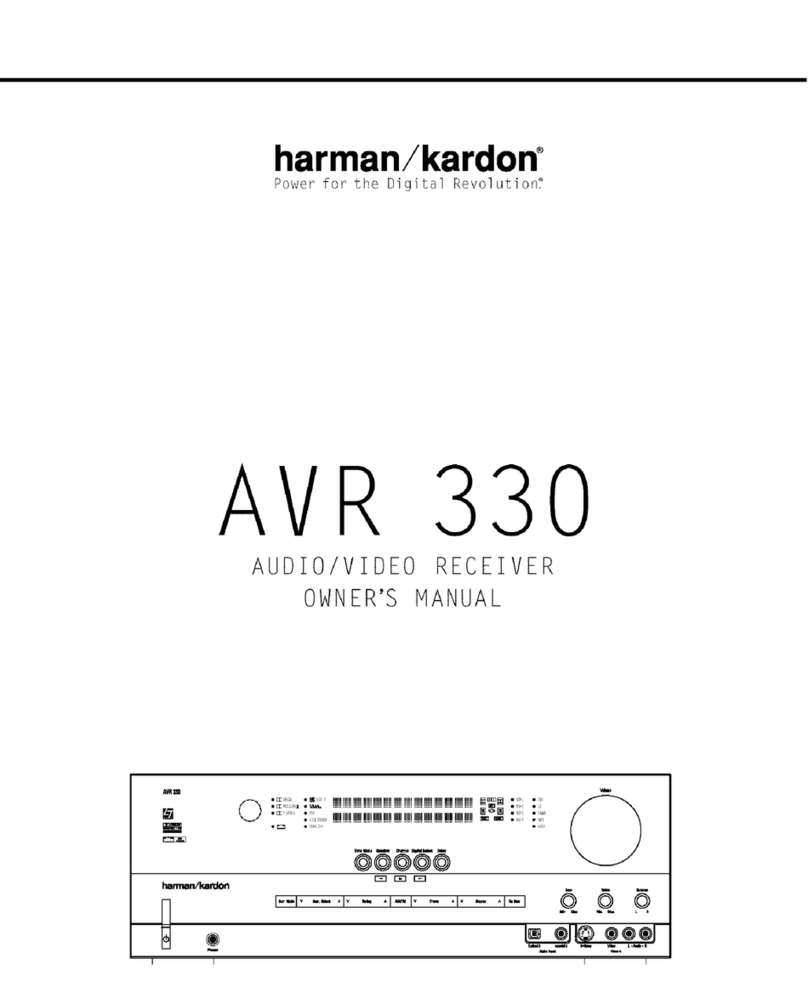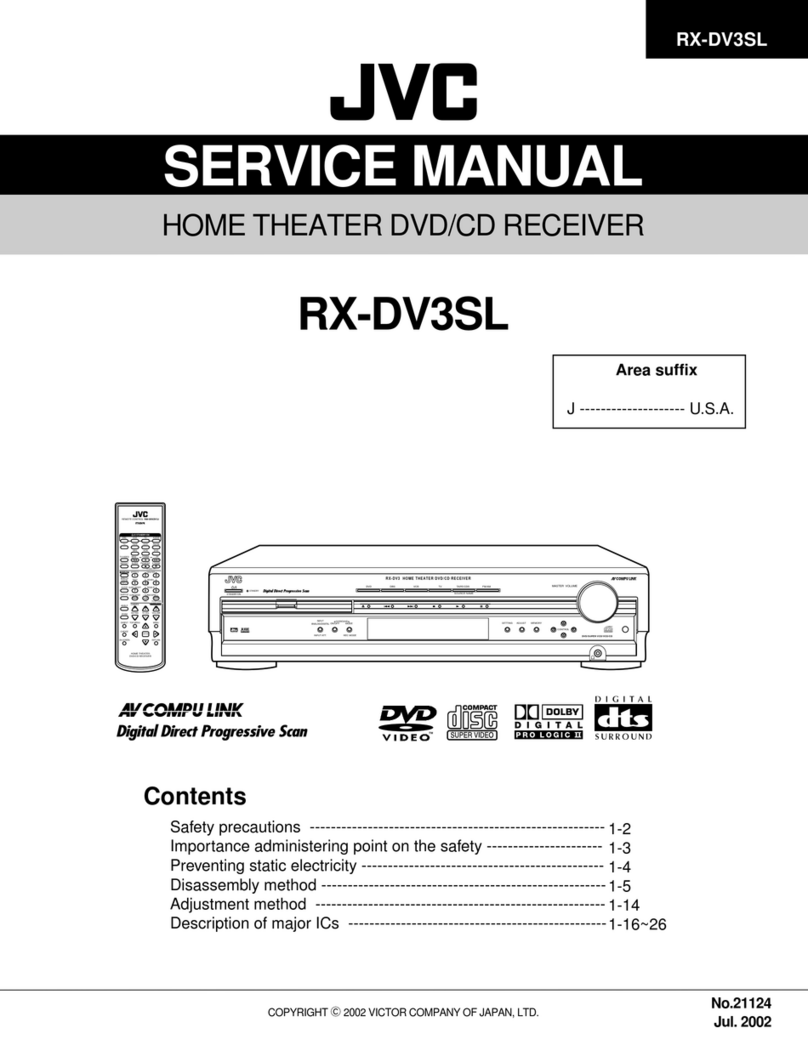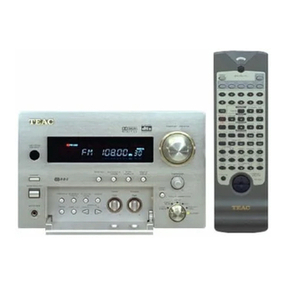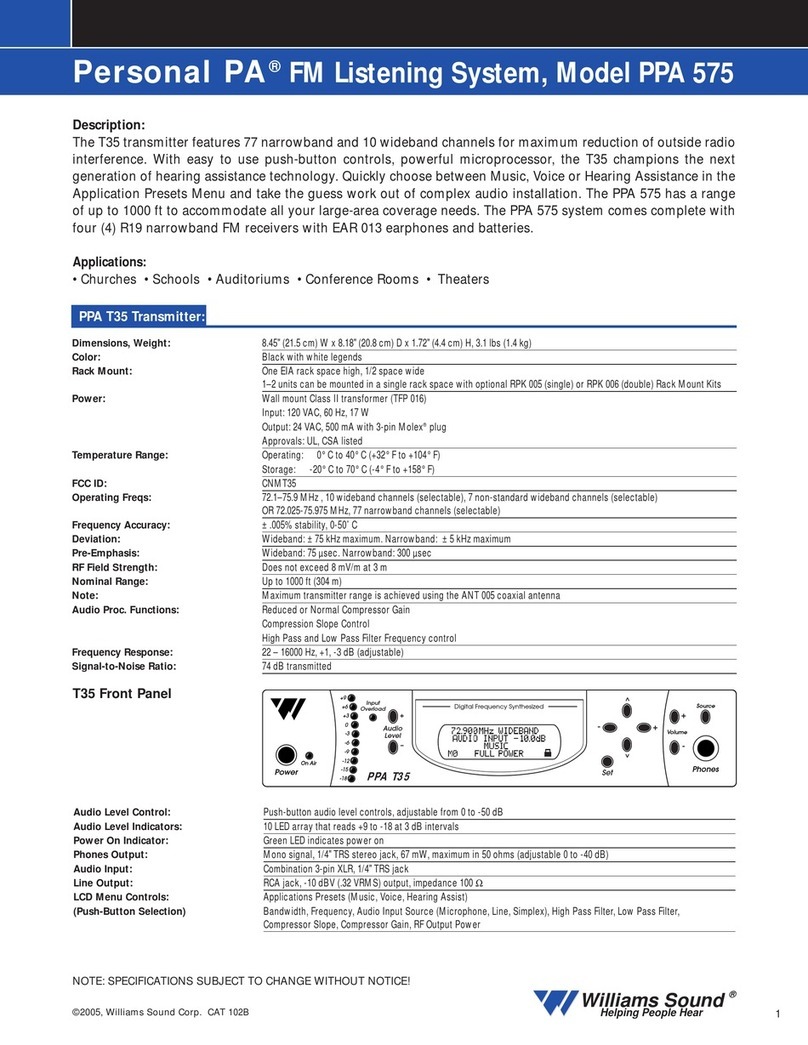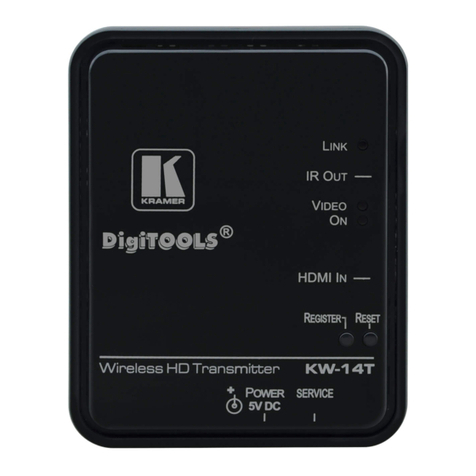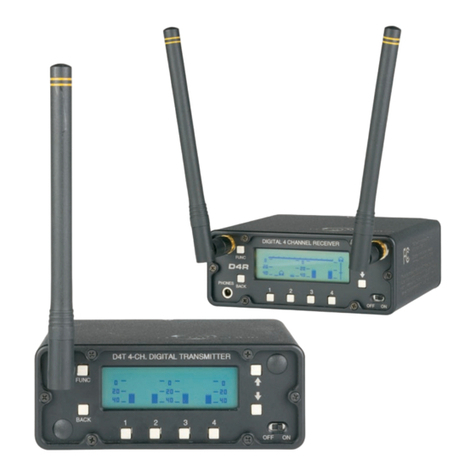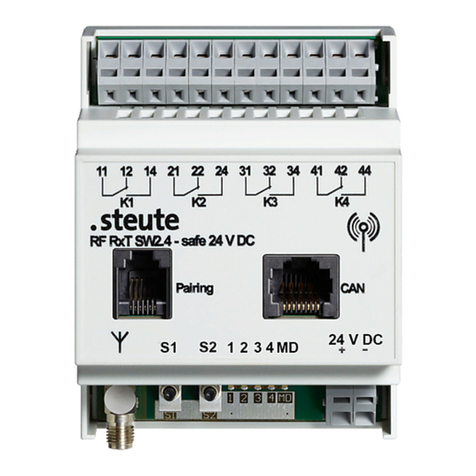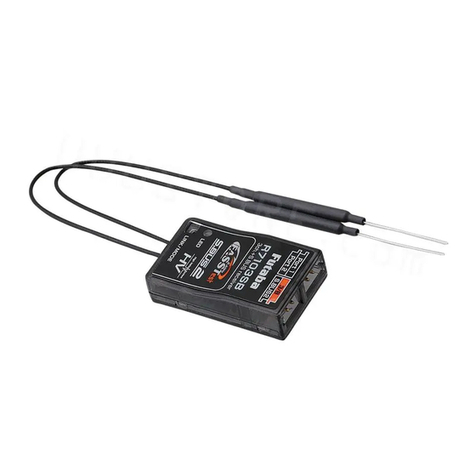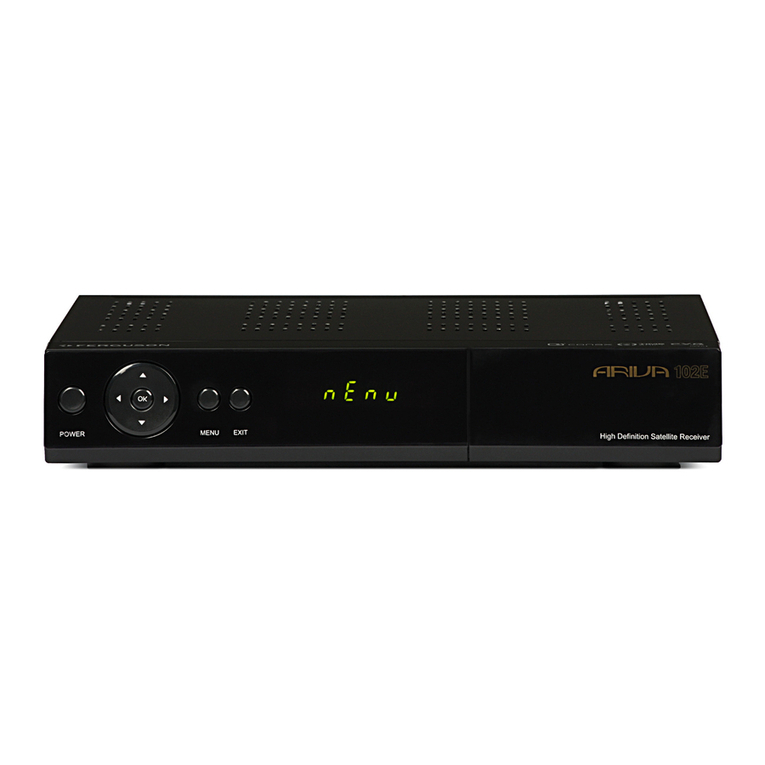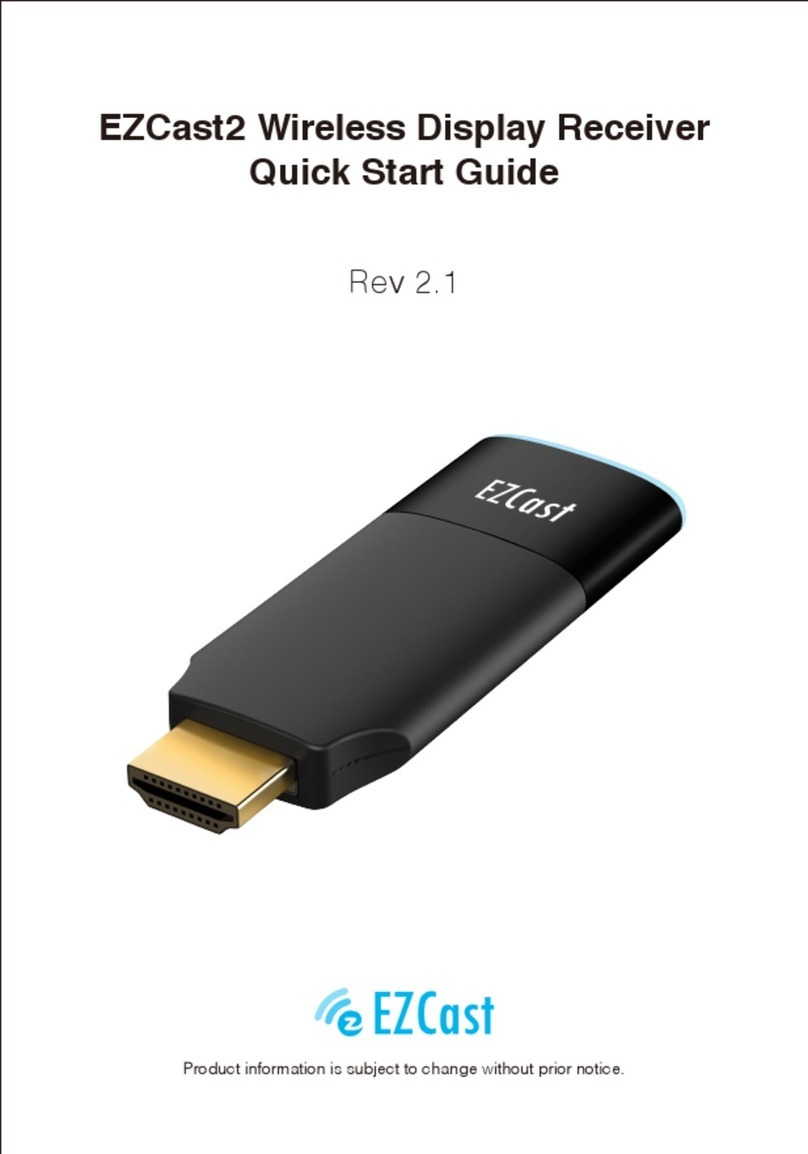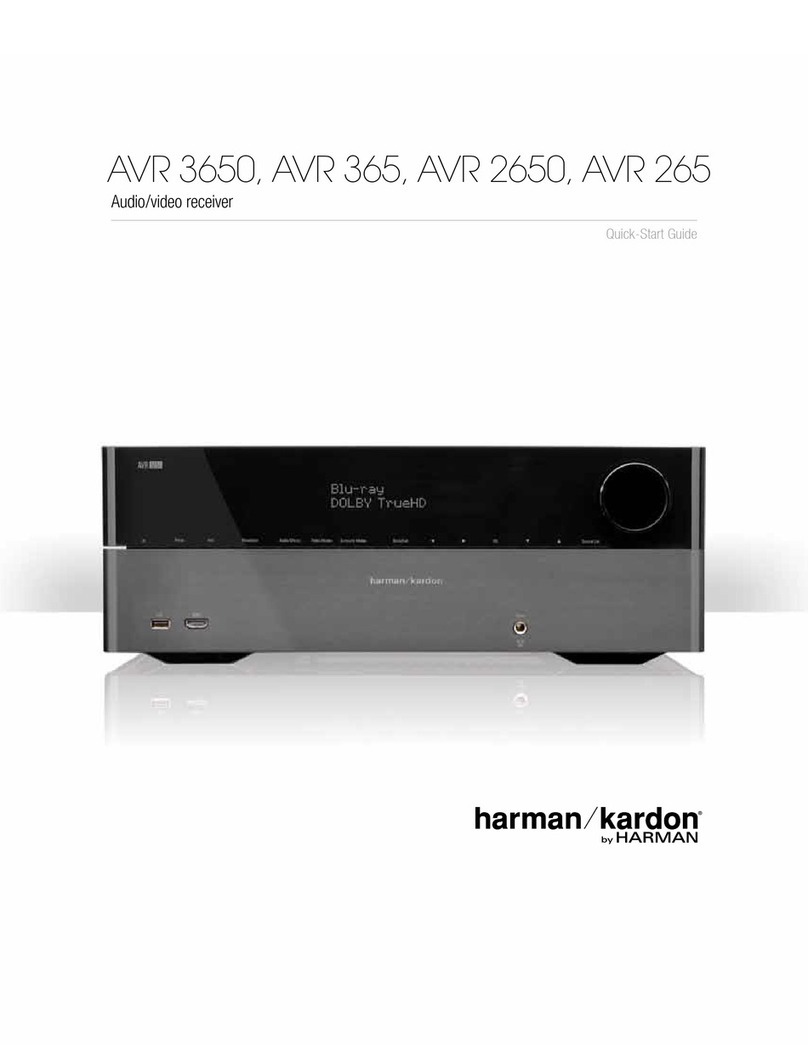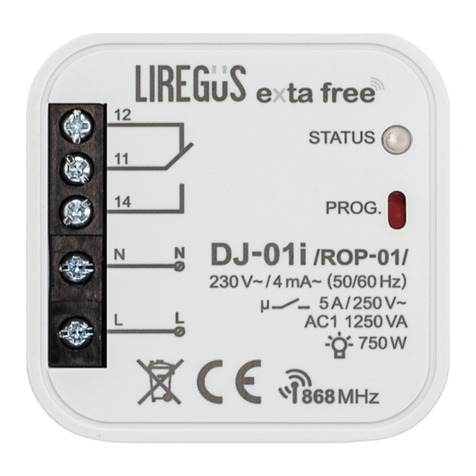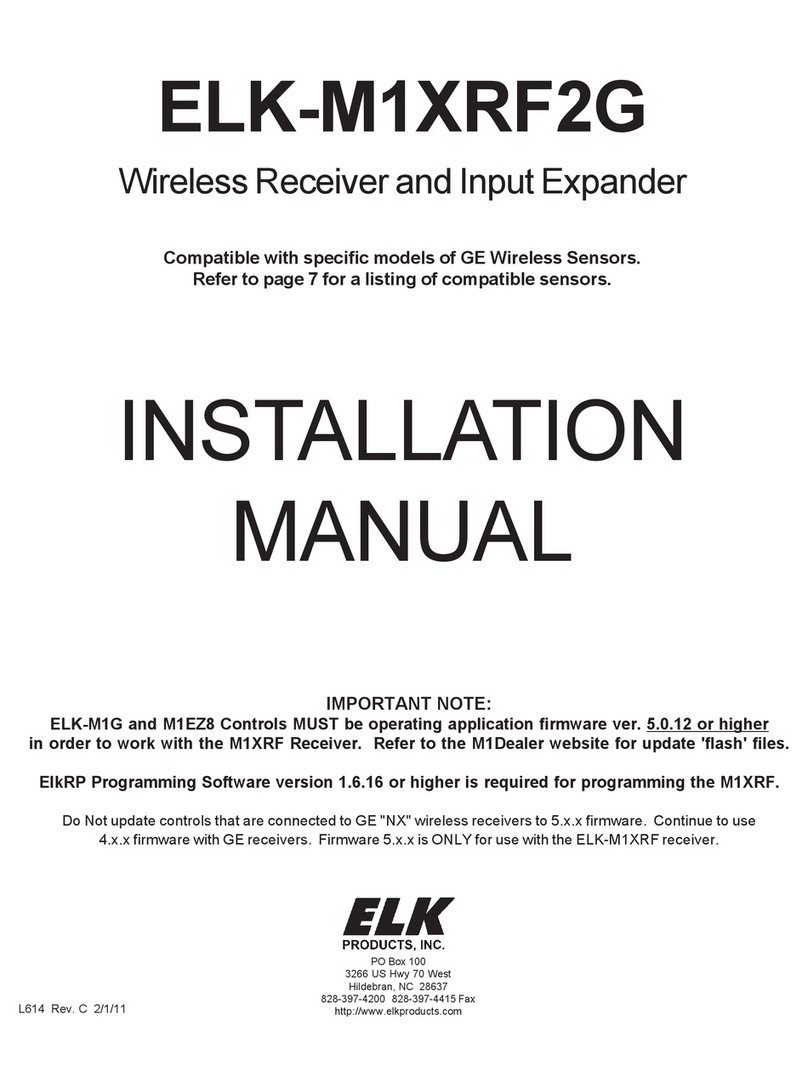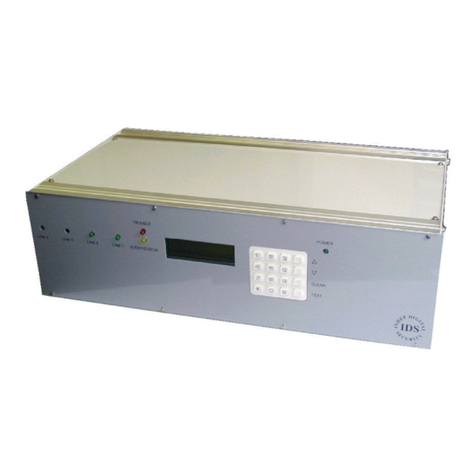DekTec DTM-3237B User manual

DTM-3237B
Compact DVB-S2X Receiver Module
with DVB-ASI Output
USER MANUAL
July 2023

DTM-3237B – DVB-S2X Receiver with DVB-ASI Output
User Manual
2
Table of Contents
Revision History ...........................................................................................................................4
1. Introduction ............................................................................................................................5
1.1 General description ...........................................................................................................5
1.2 Input Modes ......................................................................................................................5
1.3 Output Modes ...................................................................................................................5
1.4 Control and Management ..................................................................................................5
1.5 DTM-3237B Protocol Handler Source Code ........................................................................6
1.6 Theory of Operation ..........................................................................................................6
1.7 List of Abbreviations ...........................................................................................................6
1.8 References.........................................................................................................................7
2. Getting Started........................................................................................................................9
2.1 Introduction .......................................................................................................................9
2.2 Configuration: Receiving a DVB-S2X Stream........................................................................9
2.2.1 Test Set-Up................................................................................................................9
2.2.2 Configuring the DVB-S2X to ASI Conversion................................................................9
3. Layout and Installation...........................................................................................................11
3.1 Physical layout .................................................................................................................11
3.2 Mechanical Dimensions ...................................................................................................11
3.3 Order Codes ...................................................................................................................12
3.4 Hardware Installation.......................................................................................................12
3.4.1 Mechanical Installation ............................................................................................12
3.4.2 RF Connector ..........................................................................................................12
3.4.3 ASI Connector .........................................................................................................12
3.4.4 Control Connector...................................................................................................13
3.4.5 Power Connector.....................................................................................................13
3.4.6 Stream Status LED ...................................................................................................14
4. Device Configuration and Monitoring.....................................................................................15
4.1 Control Interfaces ............................................................................................................15
4.2 Control Protocol...............................................................................................................15
4.2.1 Message Format on USB..........................................................................................15
4.2.2 Message Format on I2C ...........................................................................................17
4.3 Manageable items ...........................................................................................................18
4.4 Delayed Execution............................................................................................................18
4.5 Categories.......................................................................................................................19
4.5.1 Data Types..............................................................................................................19
4.5.2 Device Properties.....................................................................................................20
4.5.3 Overall Configuration..............................................................................................21
4.5.4 Firmware Upgrade ..................................................................................................21
4.5.5 Receiver Settings......................................................................................................23
4.5.6 Receiver Status ........................................................................................................24
4.5.7 Receiver Statistics .....................................................................................................26

DTM-3237B – DVB-S2X Receiver with DVB-ASI Output
User Manual
3
4.5.8 DiSEqC Send and Receive Options ...........................................................................28
4.5.9 Satellite Information.................................................................................................28
4.6 Firmware Upgrade...........................................................................................................30
4.6.1 Firmware Upgrade - Phases .....................................................................................30
4.6.2 Firmware Upgrade - Data Encoding .........................................................................31
4.6.3 Firmware Upload - Example.....................................................................................31
5. Specifications ........................................................................................................................33
5.1 RF Input...........................................................................................................................33
5.2 Supported Modulation Parameters ....................................................................................34
5.3 DVB-ASI Input..................................................................................................................34
5.4 I2C Control Port ...............................................................................................................35
5.5 USB Control Port..............................................................................................................35
5.6 Other Specifications .........................................................................................................36
Appendix A. Mechanical Dimensions.........................................................................................37
Appendix B. DTM-3237B Development Kit.................................................................................38
Appendix C. Command-Line Tool - DtmCmd .............................................................................40
Appendix D. Communication Example .......................................................................................42
Copyright © 2023 by DekTec Digital Video B.V.
DekTec Digital Video B.V. reserves the right to change products or specifications without notice.
Information furnished in this document is believed to be accurate and reliable, but DekTec assumes
no responsibility for any errors that may appear in this material.

DTM-3237B – DVB-S2X Receiver with DVB-ASI Output
User Manual
4
Revision History
Version
Date
Changes
0.0
2023.07.15
Initial release to the field

DTM-3237B – DVB-S2X Receiver with DVB-ASI Output
User Manual
5
1. Introduction
1.1 General description
The DTM-3237B is a compact OEM module for receiving DVB-S2 or DVB-S and outputting it as
DVB-ASI. The DTM-3237B can supply LNB power and has support for sending and receiving DiSEqC
control messages. The transponder details and the output format can be configured programmatically
through several control interfaces.
Figure 1. The PCB of the DTM-3237B
A development kit (DTM-3237B-DEVKIT; refer to Appendix B) is available for easy setup and
experimentation with the DTM-3237B.
1.2 Input Modes
The DTM-3237B supports all functionality described in EN 300 421 (DVB-S), EN 302 307 (DVB-S2)
and EN 302 307-2 (DVB-S2X). All DVB-S2 modulation types can be demodulated: QPSK, 8PSK,
16/32APSK. The DTM-3237B supports advanced DVB-S2 features including VCM, ACM, Multiple
Input Streams (MIS) and Generic Stream (GS).
1.3 Output Modes
The DTM-3237B outputs the received DVB-S, DVB-S2 or DVB-S2X stream through a Transport Stream
over DVB-ASI.
1.4 Control and Management
The DTM-3237B provides options for control through either USB or I2C. Settings can be persistently
stored in non-volatile memory if the "Volatile Storage" option is set to '1'. This ensures that
configurations are retained even after power cycling. However, do note that storing settings in non-
volatile memory incurs a slight time delay and is subject to a lifetime limit on write cycles.
If "Volatile Storage" is set to '0', setting changes take immediate effect but will not be retained when
the power is cycled.
There are three control mechanisms for the DTM-3237B:
1. USB Control from a Development PC. Employ the specialized control software—either
Dtm3237BUtil or DtmCmd—on a development PC connected to the DTM-3237B via a USB
interface. This is particularly useful for initial configuration or experimenting and tweaking of
the DTM-3237B.

DTM-3237B – DVB-S2X Receiver with DVB-ASI Output
User Manual
6
2. I2C or USB Control from an Embedded Controller.If the DTM-3237B serves as a co-processor
board for satellite reception within a larger system, control can be exerted through the on-board
I2C or USB interface. In this case I2C control port is a plausible choice for the control interface,
but USB interface can also be used. The I2C address can be pre-configured using the
Dtm3237BUtil tool via USB (mechanism 1). The factory-default I2C address is 0x60.
3. Stand-Alone Operation. For situations that don't require dynamic adjustments, the DTM-3237B
can operate in a pre-configured, stand-alone mode.
Two control tools are available:
1. Dtm3237BUtil. A Windows GUI-based utility that allows you to view the DTM-3237B’s status
and adjust settings. This tool can also be used for firmware updates and is ideal for initial setup
and experimental use.
2. DtmCmd. A command-line utility designed to send commands to the DTM-3237B. It is useful
for studying the low-level commands available for the DTM-3237B. Multiple DtmCmd command
lines can be combined in a script to apply a group of settings in one go.
1.5 DTM-3237B Protocol Handler Source Code
For developers interested in building custom applications to control the DTM-3237B, a complimentary
open-source protocol handler designed for DTM-32XX series devices is available. It can be
downloaded from www.dektec.com free of charge and is royalty-free for use. The handler consists
of two source files, DtmHandler.c and DtmHandler.h, which can be compiled and linked into
your C or C++ application. Detailed instructions for incorporating the protocol handler into your
project are provided in the DtmHandler.h file.
Note:
•The command-line control tool DtmCmd is an example of an application that uses the DTM
handler. The source of DtmCmd is also available on the DekTec website. Please refer to
Appendix C for more information about DtmCmd.
1.6 Theory of Operation
Essentially, the DTM-3237B consists of two subsystems:
•A tuner, demodulator and stream processor, converting the modulated DVB-S2X input signal to
a Transport Stream on DVB-ASI;
•A processor subsystem that handles all internal/external control (USB, I2C).
1.7 List of Abbreviations
ACM
Adaptive coding and modulation
APSK
Amplitude and phase-shift keying
ASI
Asynchronous serial interface. Shorthand for DVB-ASI.
BCH
Cyclic error-correcting codes, abbreviation comprises the initials of its
inventors names (inner FEC coding used for DVB-S2)
BER
Bit error rate
CCM
Constant coding and modulation

DTM-3237B – DVB-S2X Receiver with DVB-ASI Output
User Manual
7
CNR
Carrier to noise ratio
CRC
Cyclic redundancy check
DiSEqC
Digital Satellite Equipment Control
E
b
/N
0
Energy per bit to noise power spectral density ratio
Es/N0
Energy per symbol per noise power spectral density
FEC
Forward error correction
FLASH
Non-volatile storage chip
ISI
Input stream identifier
L.3
Receiver adaptation serial output interface with in-band signaling
LDPC
Low-density parity-check code (outer FEC coding used for DVB-S2)
LNB
Low noise block
LVTTL
Low voltage transistor-transistor logic (3.3V)
Mbps
Megabit per second
MER
Modulation error rate
MIS
Multiple Input Stream
ModCod
Modulation and coding (combination of constellation and code rate)
NA
Not applicable
NC
Not connected
PSK
Phase-shift keying
QPSK
Quadrature phase-shift keying
R/W
Read / Write
RO
Read only
RS
Reed-Solomon (inner FEC coding used for DVB-S)
SIS
Single Input Stream
SNR
Signal to noise ratio
ST188
188-byte Transport Stream mode
VCM
Variable coding and modulation
WO
Write only
1.8 References
[1] DTAPI Manual - Overview and Data Formats, L.3 Baseband frame implementation. Part of
DekTec’s Windows SDK
[2] DVB-S, ETSI EN 300 421, Digital Video Broadcasting (DVB); Framing structure, channel
coding and modulation for 11/12 GHz satellite services

DTM-3237B – DVB-S2X Receiver with DVB-ASI Output
User Manual
8
[3] DVB-S2, ETSI EN 302 307, Digital Video Broadcasting (DVB); Second generation framing
structure, channel coding and modulation systems for Broadcasting, Interactive Services,
News Gathering and other broadband satellite applications.
[4] DVB-S2X, ETSI EN 302 307-2, Digital Video Broadcasting (DVB); Second generation framing
structure, channel coding and modulation systems for Broadcasting, Interactive Services,
News Gathering and other broadband satellite applications; Part 2 DVB-S2 Extensions
(DVB-S2X).

DTM-3237B – DVB-S2X Receiver with DVB-ASI Output
User Manual
9
2. Getting Started
2.1 Introduction
This section provides a walkthrough for getting started with the DTM-3237B. The description below
assumes that you have a DTM-3237B development kit available (see Appendix B). The DTM-3237B
is connected to a development PC with USB. The GUI control tool Dtm3237BUtil is used to apply
settings and observe status.
2.2 Configuration: Receiving a DVB-S2X Stream
This setup will receive a DVB-S2X stream and transmit the stream on the ASI interface.
2.2.1 Test Set-Up
For testing this configuration, a DVB-S2X signal should be connected to the DTM-3237B’s RF input.
To observe the output of the DTM-3237B, an ASI receiver is helpful1.
This tutorial assumes that a DVB-S2X stream with the following or equivalent parameters is applied to
the DTM-3237B.
Modulation standard
DVB-S or DVB-S2
Constellation
QPSK, 8PSK, 16-APSK or 32-APSK
Frequency
1150 MHz
Code rate
½
Symbol rate
27.5 MSymbol/s
RF power level
-30dBm
2.2.2 Configuring the DVB-S2X to ASI Conversion
Use Dtm3237BUtil to configure the DTM-3237B as shown in the table below. The receiver is updated
when a configuration parameter is updated using the pen icon next to each setting.
Change the following parameters:
Category
Setting
Setting name
Value
1
0x90
0x01
Receive mode
0 = Transport stream
2
0x90
0x03
Frequency (Hertz)
1150000000 = 1150MHz
3
0x90
0x09
LNB power enable
0 = Disabled
A refresh is required to see the receiver status and statistics.
The DTM-3237B will now receive a DVB-S2X stream and transmit this stream on the ASI port. The
status LED will be steady green to indicate successful transmission of the transport stream on the ASI
output. If no DVB-S2X stream is received, the status LED will flash green on and off.
1If you do not have a suitable DVB-S(2) modulator and/or ASI receiver, this functionality can, for example, be realized with
a PC and a DekTec usb modules DTU-315 and DTU-245. Please consult your local DekTec representative for more
information.

DTM-3237B – DVB-S2X Receiver with DVB-ASI Output
User Manual
10
Below you find a screenshot of the Dtm3237BUtil after all settings for the “Getting Started”
configuration has been applied and the upper left refresh arrow has been pressed to refresh all the
settings, receiver status and statistics.

DTM-3237B – DVB-S2X Receiver with DVB-ASI Output
User Manual
11
3. Layout and Installation
3.1 Physical layout
#
Field
Connector type
Description
1
RF input
MCX 75Ω
DVB-S2X input
2
ASI output
MCX 75Ω
DVB-ASI output
3
Status LED
DTM-3237B Status LED
4
Identifier
Type and revision number
5
Control
10-pin header
2.54mm pitch
I2C interface for board control
6
Power
6-pin header
2.54mm pitch
Power and reset
7
Power
Molex KK
series
2.54mm pitch
Power and reset
8
USB
Female mini-B
USB interface for board control
3.2 Mechanical Dimensions
See Appendix A.

DTM-3237B – DVB-S2X Receiver with DVB-ASI Output
User Manual
12
3.3 Order Codes
Order Code
Picture
Description
DTM-3237B
DTM-3237B – OEM DVB-S2
receiver with DVB-ASI output
DTM-3237B-DEVKIT
The DTM-3237B development kit contains the following items:
•DTM-3237B placed on four plastic studs.
•12V/1.5A power supply with three-way Molex KK connector.
•USB cable type A to mini B.
•MCX to F female cable assembly with a length of 130 mm.
•MCX to BNC cable assembly with a length of 130 mm.
3.4 Hardware Installation
3.4.1 Mechanical Installation
The unit can be mounted onto a support plate by means of four 3 mm bolts and appropriate spacers.
Ensure that there is sufficient airflow to provide cooling of the board.
3.4.2 RF Connector
RF connector (1) is a MCX connector with an impedance of 75 ohm.
3.4.3 ASI Connector
ASI connector (2) is a MCX connector with an impedance of 75 ohm.

DTM-3237B – DVB-S2X Receiver with DVB-ASI Output
User Manual
13
3.4.4 Control Connector
The pinning of the control connector is shown in the table below. It’s a dual row pin header for
connecting the I2C control bus, lock indicator and analog signal level.
Pin
Function
Pin
Function
1
NC
2
Analog Signal level
3
NC
4
Lock indicator
5
NC
6
NC
7
GND
8
I2C SCL
9
I2C SDA
10
I2C SCL
An I2C controller can be connected to SDA and SCL on pin 9 and 8/10, with signal ground on pin 7.
3.4.5 Power Connector
The DTM-3237B must be powered from an external source with a voltage of 12V DC. Power
consumption is max. 5W without the LNB power enabled. Two power connectors are available,
connector 6 and 7. Please refer to §3.1- Physical layout for the connector layout. The pinning of these
power connectors is shown below.
Connector 6 – Pin header 2.54 mm pitch
Pin
Function
Pin
Function
1
+12V DC in
2
+12V DC in
3
Ground
4
Ground
4
Reset
6
Reset
Connector 7 - Molex KK series 2.54 mm
pitch
Pin
Function
1
+12V DC in
2
Ground
3
Reset
The board can be reset by pulling the reset pin to ground for at least 100ns. The reset pin is connected
with a resistor to the 12V DC input voltage. When connecting a driver to the reset pin of the
DTM-3237B, make sure it is 12V tolerant. To trigger a reset, the voltage on the reset pin shall be
700mV or less.

DTM-3237B – DVB-S2X Receiver with DVB-ASI Output
User Manual
14
3.4.6 Stream Status LED
The status LED indicates the status of the DVB-S2X receiver and the ASI output stream. The following
colors are used for status indication:
Continuous green
Valid DVB-S2X signal detected and
generating signal on DVB-ASI output
Short green flashes
No DVB-S2X signal detected and no output
generated on DVB-ASI output
Short red/green flashes
The DTM-3237B is in firmware upgrade
mode. This modes allows:
1) Upgrading the firmware and go back to
normal operation afterwards
2) Go to normal operation (in case valid
firmware is present)
Red flashes
Internal device error.
If resetting the device does not help,
contact DekTec support.

DTM-3237B – DVB-S2X Receiver with DVB-ASI Output
User Manual
15
4. Device Configuration and Monitoring
4.1 Control Interfaces
The DTM-3237B can be configured and monitored via a serial control protocol on USB or I2C. The
USB interface uses a serial port emulator running at 256kBaud. It is not required to select between the
control ports, the DTM-3237B will automatically use the interface on which it detects activity.
The I2C address is a special parameter that can only be configured through the USB interface (e.g.
with Dtm3237BUtil). Alternatively, the defaults can be used:
•The default I2C address is 0x60.
The USB uses the control protocol that is described below. I2C uses the same protocol, but slightly
different message formatting.
4.2 Control Protocol
Commands and responses are wrapped into messages described below. The DTM-3237B accepts
uppercase and lowercase characters, but will always respond in uppercase.
4.2.1 Message Format on USB
Field
Format
Description
Start
ASCII character
STX (0x02)
ASCII “start of text” character
Address
2 hex digits2
8-bit address3
Category
2 hex digits
Selects a “category” of settings
Setting
2 hex digits
Selects a setting within the selected category
Read/Write
ASCII character
‘R’ or ‘W’
‘R’ for read and ‘W’ for write
Index
4 hex digits
Provides an extra index parameter, e.g. to indicate the
channel number
4
Data
n hex digits / n
ASCII characters
The data written or read. The data length is variable for
each setting. In case of a write operation, the data is a
(negative) acknowledgement
Checksum
2 hex digits
This is the least significant byte of the two’s complement5
sum of all characters in the message, excluding the STX and
ETX characters and the checksum itself
End
ASCII character
ETX (0x03)
2Hex digits are the ASCII characters 0…9 and A…F, concatenated to form a single hexadecimal value.
3USB and LVTTL serial are point-to-point connections, so there is no address and the address field is a don’t care.
4The DTM-3237B supports a single channel only, so when index is used as a channel number, it’s always 0.
5Invert all bits and add one.

DTM-3237B – DVB-S2X Receiver with DVB-ASI Output
User Manual
16
Figure 2 below shows the structure of a command or response message written through the serial
interface. If the command is a 'read', the data may be omitted. Note that some settings require an
index.
Figure 2. Message on an USB serial control interface
All commands successfully sent to the DTM-3237B are answered with a copy of the command
including the data bytes.
When an incorrect checksum or an invalid hex value is detected, the DTM-3237B will not return an
answer. When protocol errors are detected, e.g. a combination of a valid category with an invalid
setting, the R/W byte of the reply is replaced with the ASCII character ‘E’ and the data is removed from
the message.
Please refer to Appendix D for a communication example.

DTM-3237B – DVB-S2X Receiver with DVB-ASI Output
User Manual
17
4.2.2 Message Format on I2C
Field
Format
Description
Start
S
Standard I2C start condition
Address
I2C address byte
7-bit I2C address followed by the I2C R/W bit, which is set to
0 and 1 in the command- and response sequence
respectively
Category
1 byte
Selects a “category” of settings
Setting
1 byte
Selects a setting within the selected category
Read/Write
1 byte
0x01 for read and 0x00 for write
Index
2 bytes
Provides an extra index parameter, e.g. to indicate the
channel number
6
Data
n bytes
The data written or read. The data length is variable for
each setting. In case of a write operation, the actual data is
returned as a (negative) acknowledgement
Checksum
1 byte
This is the least significant byte of the two's complement of
the sum of the 7-bit I2C slave address and all data-bytes in
the I2C message (excluding the checksum). The I2C R/W bit
is not included, an incorrect value of this bit would cause the
checksum to be not received at all.
End
P
Standard I2C stop condition. A repeated start condition can
be used at all times to concatenate multiple I2C read / write
actions
Figure 3 below shows the sequence to send a command over I2C to the DTM-3237B. In the examples
below, grey areas in the timing diagrams are sent by the DTM-3237B, while white areas are sent by
the I2C master. If the command is a read-command, the data may be omitted. Note that some settings
require an index.
Figure 3. Command (upper sequence) and response (lower) sequence for I2C
6The DTM-3237B supports a single channel only, so when index is used as a channel number, it’s always 0.

DTM-3237B – DVB-S2X Receiver with DVB-ASI Output
User Manual
18
When an incorrect checksum is detected, the DTM-3237B will not return an answer. When a protocol
error is detected, e.g. a combination of a valid category with an invalid setting, the R/W byte of the
reply is replaced by the ASCII character ‘E’ and the data is removed from the message.
When a master starts writing to a device while the previous command is still being executed, the device
will ignore the data.
When a master starts reading from a device while there is no answer available (yet), the device will
reply with the value 0x00. The value 0x00 will be returned until an answer is available and the master
has initiated a new read transaction.
S and P are the standard I2C start and stop conditions.
Please refer to Appendix D for a communication example.
4.3 Manageable items
The tables in the sections below provide lists of variables that can be configured and/or monitored
using USB or I2C.
The ‘Access’ column indicates whether the variable is writeable, according to the table below.
Access
Description
RO
Read only
WO
Write only
R/W
Read and/or write
R/Wusb
Read from all interfaces, write from USB only
NA
Not applicable
DE-XXX
Delayed execution (see §4.4 - Delayed Execution)
4.4 Delayed Execution
Most items are processed directly when the read or write command is received, which will immediately
result in an action on the device. In contrast to these directly processed items, some items require more
processing time and therefor these actions are performed with a delay in a background thread. Items
which execution is delayed are marked with a “DE” (delayed execution) prefix in the access column.
Items which execution is delayed can be monitored by the “Busy” item (category 0x01, setting 0x0C).
During the execution of these items, the “Busy” item is set and it is not possible to execute other “DE”
marked items. In case the “Busy” item is set and a “DE” marked command is received, the device will
return with a ‘B’ (busy) result in the Read/Write field of the DTM protocol frame structure.

DTM-3237B – DVB-S2X Receiver with DVB-ASI Output
User Manual
19
4.5 Categories
Manageable Items – Categories
Nr
Settings Category
Description
Index?
0x01
Device
Device properties
No
0x02
Configuration
Overall configuration
No
0x85
Firmware upgrade
Firmware upgrade type 2
Yes
0x90
Receiver settings
Receiver settings
Yes
0x91
Receiver status
Receiver status
Yes
0x92
Receiver statistics
Receiver statistics
Yes
0x93
DiSEqC
DiSEqC send and receive commands
Yes
0x94
Satellite Info
Satellite Information
Yes
4.5.1 Data Types
Manageable Items – Data types
Type
Description
LVTTL serial control port
I2C
uint8
8-bit unsigned integer
2 chars
1 byte
int32
32-bit signed integer
8 chars
4 bytes
uint32
32-bit unsigned integer
8 chars
4 bytes
uint64
64-bit unsigned integer
16 chars
8 bytes
All data types are sent with the most-significant byte first.

DTM-3237B – DVB-S2X Receiver with DVB-ASI Output
User Manual
20
4.5.2 Device Properties
Manageable Items – Category 0x01 – Device properties
Nr
Variable
Description
Access
Type
0x00
All
All settings in this category
RO
25 bytes
0x01
FPGA version
Version number of the FPGA code on-
board of the DTM-3237B
RO
uint8
0x03
Firmware version
Firmware version: the major version is
encoded in the tens, the minor version
in the units, e.g. ’10’ indicates v1.0
RO
uint32
0x04
Serial number
Unique serial number for this device,
e.g. 3237.000.010
RO
uint32
0x05
Type
Device type number, e.g. 3237
RO
uint32
0x06
Hardware revision
Hardware revision number,
e.g. 302 = 3.2
RO
uint32
0x07
Bootloader
version
Bootloader version number
RO
uint8
0x08
Production date
Production date of this board
Bit 31..8: Year
Bit 7..0: Month
RO
uint32
0x09
I2C address
7-bit I2C address
Limitations:
- Bit 0 (I2C R/W bit) can't be set
- Address range 0x08 to 0x76
Changes to the I2C address are
automatically persisted in flash
memory.
Default: 0x60
R/Wusb
uint8
0x0B
Subtype
Device subtype, e.g.0=none, 1=A, ...
RO
uint8
0x0C
Busy
Device busy flag
0 = Ready
1 = Processing “DE” marked items
RO
uint8
Table of contents
